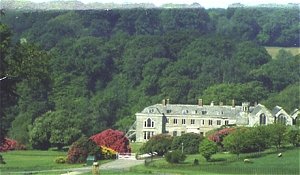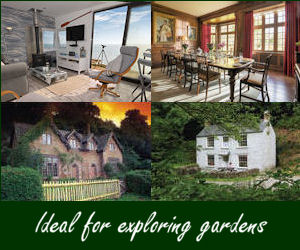Boconnoc
| Contact | Mr & Mrs Anthony Fortescue |
| Enquiries | 01208 872507 |
| Fax | 01208 873836 |
| office@boconnoc.com | |
| Website | www.boconnoc.com |
| The picturesque park was created by Thomas Pitt in 1780 and surrounds the recently restored lake and Golden Jubilee walk. The 19th century pinetum now includes Lobb's collection together with beautiful gardens, magnificent trees, flowering shrubs and outstanding views. | |
| Open | Pre booking required (for groups of 10 and over). Plus the Garden is open for charity on three Sundays from the 8th May 2016 14:00 - 1700 |
| Admission | Adults: Garden £4:50 House £4:00 pp. Guided Tours are available Tues 12 and Wed 20 May, Tues 16 June, 7 Jul and 15 Sept 2016 £18.00 pp. Pre-arranged parties: available to groups of 12+ £12 pp. Lunches or buffet lunches, teas and coffee can be arranged. |
The first recorded owners were the De Cant family (1268) and in 1320 - 1386, the Manor was owned by the Carminows. Latterly by Sir Oliver Carminow who married a daughter of Joan Holland (The Fair Maid of Kent), a grand-daughter of Edward I who married the Black Prince as her second husband, for whom the Duchy of Cornwall was created.
In the grounds (actually the largest park in Cornwall) can be seen the church, of which the dedication is unknown, but was thought to have been consecrated in 1413.
Through the centuries, Boconnoc has been associated with many of this country's famous names and history-makers including Lord Russell, Earl of Bedford who sold Boconnoc in 1579 to Sir William Mohun who rebuilt it.
During the Civil War 1642-1646 period Boconnoc was involved in two significant battles. In January 1643 the Parliament forces under Col. Ruthven impatiently attempted to enter Cornwall, which was strongly Royalist. The opposing forces met near Braddock Church, the Royalists being commanded by Bevil Grenville and Ralph Hopton (both subsequently Knighted) marching from Boconnoc Park where they had bivouacked overnight. In a short time the Parliament forces were routed. A more important clash took place the following year. The King made his headquarters at Boconnoc and the unfortunate Roundheads were gradually squeezed into Lostwithiel and Fowey, to their ultimate surrender at Castle Dore.
Later, Thomas Pitt purchased the estate with the proceeds of the famous Pitt Diamond which he sold to the Regent of France where it ended up in the hilt of Napoleon's sword. Pitt's grandson, William, became Prime Minister.
The c.17 deer park and woodland were landscaped in the late c.18 and early c.19, and at its most extensive c. 60ha, within larger estate with large areas of woodland, moor land and agricultural land. The garden and lawn around the House extend to c.1ha.
In 1786 Sir John Soane made substantial alterations to the house and stables, and constructed a new top for the most prominent monument is the Obelisk which is 123 feet high and was erected in 1771 by Thomas Pitt, 1st Lord Camelford, in memory of his wife's uncle and benefactor, Sir Richard Lyttelton. It is situated between Boconnoc and Braddock churches in the middle of an old military entrenchment near to where the Battle of Braddock Down was fought in the Civil War 1642-1646.
The parsonage and glebe of Boconnoc were annexed to the park and grounds of Boconnoc House, by Act of Parliament, in 1806 when a new rectory house was built at Broadoak (Bradock) to serve both parishes. The old parsonage became the home of the Steward of the Boconnoc Estate, and is located behind Boconnoc House in a secluded valley, among majestic trees.
In 1820 the estate was bequeathed to the Fortescue family who still own it although, since 1969 the house has not been lived in due to deterioration and subsidence as is currently being restored.
Nineteenth century commercial activities, including lead and iron mining, gradually gave way to an emphasis on farming.
During the Second World War, Boconnoc House and the surrounding buildings were occupied by American troops and the grounds used as an ammunition dump in preparation for the invasion of Europe in 1944.
Boconnoc still has its deer park. There are approximately 100 head of deer in the Deer Park contained within the grounds. The gardens filled with azaleas, camellias and rhododendrons Boconnoc House and Park have been used for numerous film locations including the BBC Poldark series and scenes from the 1993 film of The Three Musketeers.
Presented by the Cornwall Garden Society, The Cornwall Spring Flower Show is hosted at Boconnoc during April, when members of the public may come to experience the wealth of Cornwall's flowers and plants displayed in the beautiful surroundings of the Boconnoc Estate.
The gardens are open to the public on four Sunday afternoons from the end of April in aid of charities The Gardens are available at other times for groups of 10 and over. The private garden visits may be arranged to include visits to:
The 15th century Church The Deer Park and Cricket Pitch The restoration of Boconnoc House An estate tour including the water powered saw mill The Viewing the locations used for filming
Lunches or buffet lunches, teas and coffee can be arranged. (Contact the Estate Office to make a reservation)



